Effect of Quench Tempering on Hydrogen Embrittlement and Corrosion Behavior of X100 Pipeline Steel
Abstract
1. Introduction
2. Materials and Methods
3. Results and Discussion
3.1. Mechanical Properties
3.2. Corrosion Analysis and Texture Evolution
4. Conclusions
- The HT2 specimen had the potential to retain a high impact toughness value even after hydrogen charging, indicating a higher amount of hydrogen embrittlement resistance. On the other hand, the Ref. and HT3 specimens with high hardness values showed higher hydrogen embrittlement susceptibility, indicating that the hydrogen embrittlement resistance decreased with increasing hardness values.
- The corrosion test results indicate that the corrosion resistance of the Ref. and heat-treated specimens can be arranged in the following order: HT3 < Ref. < HT1 < HT2. This result originates from the crystallographic texture analysis, which indicates that the HT1 and HT2 steel with the optimum combination of advantageous texture components ({110}, {111},{332}) and harmful texture components ({100}) exhibited a superior level of corrosion resistance in the acidic environments.
- The EBSD analysis of the KAM maps indicated that the HT3 and Ref. Please put here “Not applicable” have the highest amount of internally stored energy, resulting in the lowest corrosion resistance.
Author Contributions
Funding
Institutional Review Board Statement
Informed Consent Statement
Data Availability Statement
Acknowledgments
Conflicts of Interest
References
- Pourazizi, R.; Mohtadi-Bonab, M.A.; Zadeh Davani, R.K.; Szpunar, J.A. Effect of Thermo-Mechanical Controlled Process on Microstructural Texture and Hydrogen Embrittlement Resistance of API 5L X70 Pipeline Steels in Sour Environments. Int. J. Press. Vessel. Pip. 2021, 194, 104491. [Google Scholar] [CrossRef]
- Entezari, E.; González-Velázquez, J.L.; López, D.R.; Zúñiga, M.A.B.; Szpunar, J.A. Review of Current Developments on High Strength Pipeline Steels for HIC Inducing Service. Frat. Ed Integrità Strutt. 2022, 16, 20–45. [Google Scholar] [CrossRef]
- Sharma, L.; Chhibber, R. Microstructure Evolution and Electrochemical Corrosion Behaviour of API X70 Linepipe Steel in Different Environments. Int. J. Press. Vessel. Pip. 2019, 171, 51–59. [Google Scholar] [CrossRef]
- González-Velázquez, J.L.; Entezari, E. On the Assessment of Non-Metallic Inclusions by Part 13 of API 579 -1/ASME FFS-1 2016. Procedia Struct. Integr. 2021, 33, 221–228. [Google Scholar] [CrossRef]
- Kpemou, A.M.; Guy, P.; Julien, C. Influence of Hydrogen Embrittlement on Ductile–Brittle Transition Temperature Determined on Mini-Charpy Specimens Made in X65 Steel. J. Fail. Anal. Prev. 2021, 21, 2290–2304. [Google Scholar] [CrossRef]
- Fassina, P.; Bolzoni, F.; Fumagalli, G.; Lazzari, L.; Vergani, L.; Sciuccati, A. Influence of Hydrogen and Low Temperature on Mechanical Behaviour of Two Pipeline Steels. Eng. Fract. Mech. 2012, 81, 43–55. [Google Scholar] [CrossRef]
- Coseru, A.; Capelle, J.; Pluvinage, G. On the Use of Charpy Transition Temperature as Reference Temperature for the Choice of a Pipe Steel. Eng. Fail. Anal. 2014, 37, 110–119. [Google Scholar] [CrossRef]
- Johnson, W.H., II. On Some Remarkable Changes Produced in Iron and Steel by the Action of Hydrogen and Acids. Proc. R. Soc. London 1875, 23, 168–179. [Google Scholar] [CrossRef]
- Zhang, T.; Zhao, W.; Li, T.; Zhao, Y.; Deng, Q.; Wang, Y.; Jiang, W. Comparison of Hydrogen Embrittlement Susceptibility of Three Cathodic Protected Subsea Pipeline Steels from a Point of View of Hydrogen Permeation. Corros. Sci. 2018, 131, 104–115. [Google Scholar] [CrossRef]
- Magnin, T. Mécanismes de Fatigue-Corrosion Des Alliages Métalliques. Rev. Métallurgie 2002, 99, 423–432. [Google Scholar] [CrossRef]
- Steigerwald, E.A.; Schaller, F.W.; Troiano, A.R. The Role of Stress in Hydrogen Induced Delayed Failure. Trans. Met. Soc. AIME 1960, 218. [Google Scholar]
- Gong, K.; Wu, M.; Liu, G. Comparative Study on Corrosion Behaviour of Rusted X100 Steel in Dry/Wet Cycle and Immersion Environments. Constr. Build. Mater. 2020, 235, 117440. [Google Scholar] [CrossRef]
- Gong, K.; Wu, M.; Xie, F.; Liu, G.; Sun, D. Effect of Dry/Wet Ratio and PH on the Stress Corrosion Cracking Behavior of Rusted X100 Steel in an Alternating Dry/Wet Environment. Constr. Build. Mater. 2020, 260, 120478. [Google Scholar] [CrossRef]
- Zhao, J.; Wang, S.; Gu, Y.; Xiong, D.; Tian, B. Microstructure and Corrosion Performance of X100 Steel in the Oilfield Produced Water. Corros. Eng. Sci. Technol. 2019, 54, 649–658. [Google Scholar] [CrossRef]
- González Velázquez, J.L.; Entezari, E.; López, D.R.; Beltrán Zúñiga, M.A.; Szpunar, J. Experimental and In-Service Observations of HIC Nucleation and Growth in Pipeline Steel. In 49th Annual Review of Progress in Quantitative Nondestructive Evaluation; American Society of Mechanical Engineers: New York, NY, USA, 2022; Volume 2022. [Google Scholar] [CrossRef]
- Eliyan, F.F.; Alfantazi, A. Electrochemical Investigations on the Corrosion Behavior and Corrosion Natural Inhibition of API-X100 Pipeline Steel in Acetic Acid and Chloride-Containing CO2-Saturated Media. J. Appl. Electrochem. 2012, 42, 233–248. [Google Scholar] [CrossRef]
- Dong, C.F.; Liu, Z.Y.; Li, X.G.; Cheng, Y.F. Effects of Hydrogen-Charging on the Susceptibility of X100 Pipeline Steel to Hydrogen-Induced Cracking. Int. J. Hydrogen Energy 2009, 34, 9879–9884. [Google Scholar] [CrossRef]
- Pourazizi, R.; Mohtadi-Bonab, M.A.; Szpunar, J.A. Investigation of Different Failure Modes in Oil and Natural Gas Pipeline Steels. Eng. Fail. Anal. 2020, 109, 104400. [Google Scholar] [CrossRef]
- Entezari, E.; Avishan, B.; Mousalou, H.; Yazdani, S. Effect of Electro Slag Remelting (ESR) on the Microstructure and Mechanical Properties of Low Carbon Bainitic Steel. Kov. Mater 2018, 56, 253–263. [Google Scholar] [CrossRef]
- Pourazizi, R.; Mohtadi-Bonab, M.A.; Szpunar, J.A. Role of Texture and Inclusions on the Failure of an API X70 Pipeline Steel at Different Service Environments. Mater. Charact. 2020, 164, 110330. [Google Scholar] [CrossRef]
- Entezari, E.; Mousalou, H.; Yazdani, S.; González-Velázquez, J.L.; Szpunar, J.A. The Evaluation of Quenching Temperature Effect on Microstructural and Mechanical Properties of Advanced High Strength Low Carbon Steel After Quenching Partitioning Treatment. Procedia Struct. Integr. 2022, 37, 145–152. [Google Scholar] [CrossRef]
- Masoumi, M.; Silva, C.C.; Béreš, M.; Ladino, D.H.; de Abreu, H.F.G. Role of Crystallographic Texture on the Improvement of Hydrogen-Induced Crack Resistance in API 5L X70 Pipeline Steel. Int. J. Hydrogen Energy 2017, 42, 1318–1326. [Google Scholar] [CrossRef]
- Fuchigami, H.; Minami, S.H.; Nagumo, M. Effect of Grain Size on the Susceptibility of Martensitic Steel to Hydrogen-Related Failure. Philos. Mag. Lett. 2006, 86, 21–29. [Google Scholar] [CrossRef]
- Masoumi, M.; Silva, C.C.; de Abreu, H.F.G. Effect of Crystallographic Orientations on the Hydrogen-Induced Cracking Resistance Improvement of API 5L X70 Pipeline Steel under Various Thermomechanical Processing. Corros. Sci. 2016, 111, 121–131. [Google Scholar] [CrossRef]
- Ohaeri, E.; Omale, J.; Tiamiyu, A.; Rahaman, K.M.M.; Szpunar, J. Influence of Thermomechanically Controlled Processing on Microstructure and Hydrogen Induced Cracking Susceptibility of API 5L X70 Pipeline Steel. J. Mater. Eng. Perform. 2018, 27, 4533–4547. [Google Scholar] [CrossRef]
- Omale, J.I.; Ohaeri, E.G.; Szpunar, J.A.; Arafin, M.; Fateh, F. Microstructure and Texture Evolution in Warm Rolled API 5L X70 Pipeline Steel for Sour Service Application. Mater. Charact. 2019, 147, 453–463. [Google Scholar] [CrossRef]
- Schreiber, A.; Rosenkranz, C.; Lohrengel, M.M. Grain-Dependent Anodic Dissolution of Iron. Electrochim. Acta 2007, 52, 7738–7745. [Google Scholar] [CrossRef]
- Madrigal-Cano, M.; Hernández-Maya, L.; Hallen, J.M.; Corrales-Luna, M.; Arce-Estrada, E.M.; Le Manh, T. Model for the Correlation between Anodic Dissolution Resistance and Crystallographic Texture in Pipeline Steels. Materials 2018, 11, 1432. [Google Scholar] [CrossRef]
- Ohaeri, E.; Omale, J.; Eduok, U.; Szpunar, J. Effect of Thermomechanical Processing and Crystallographic Orientation on the Corrosion Behavior of API 5L X70 Pipeline Steel. Metall. Mater. Trans. A 2018, 49, 2269–2280. [Google Scholar] [CrossRef]
- Ohaeri, E.; Omale, J.; Eduok, U.; Szpunar, J.; Arafin, M.; Fazeli, F. Effect of Microstructure and Texture Evolution on the Electrochemical Corrosion Behavior of Warm-Rolled API 5L X70 Pipeline Steel. Metall. Mater. Trans. Part A 2020, 51, 2255–2275. [Google Scholar] [CrossRef]
- Venegas, V.; Caleyo, F.; Baudin, T.; Espina-Hernández, J.H.; Hallen, J.M. On the Role of Crystallographic Texture in Mitigating Hydrogen-Induced Cracking in Pipeline Steels. Corros. Sci. 2011, 53, 4204–4212. [Google Scholar] [CrossRef]
- Hoschke, J.; Chowdhury, M.F.W.; Venezuela, J.; Atrens, A. “A review of hydrogen embrittlement in gas transmission pipeline steels”. Corros. Rev. 2023. [Google Scholar] [CrossRef]
- Roy, U.; McDowell, D.L.; Zhou, M. Effect of Grain Orientations on Fracture Behavior of Polycrystalline Metals. J. Mech. Phys. Solids 2021, 151, 104384. [Google Scholar] [CrossRef]
- Mohtadi-Bonab, M.A.; Mousavi, H.; Pourazizi, R.; Szpunar, J.A. Finite Element Modeling of Hic Propagation in Pipeline Steel with Regard to Experimental Observations. Int. J. Hydrogen Energy 2020, 45, 23122–23133. [Google Scholar] [CrossRef]
- Lee, S.-P.; Hwang, S.-K.; Lee, J.-K.; Son, I.-S.; Bae, D.-S. Effect of Hydrogen Charging on the Mechanical Properties of 304 Stainless Steels. J. Korea Soc. Power Syst. Eng. 2015, 19, 73–79. [Google Scholar] [CrossRef]
- Huang, F.; Liu, J.; Deng, Z.J.; Cheng, J.H.; Lu, Z.H.; Li, X.G. Effect of Microstructure and Inclusions on Hydrogen Induced Cracking Susceptibility and Hydrogen Trapping Efficiency of X120 Pipeline Steel. Mater. Sci. Eng. A 2010, 527, 6997–7001. [Google Scholar] [CrossRef]
- Peng, Z.; Liu, J.; Huang, F.; Zhang, S.; Hu, Q.; Wang, Z.; Wang, Y. The Significance of Inclusion Morphology and Composition in Governing Hydrogen Transportation and Trapping in Steels. Int. J. Hydrogen Energy 2021, 46, 28811–28822. [Google Scholar] [CrossRef]
- Moon, J.; Kim, S.-J.; Lee, C. Role of Ca Treatment in Hydrogen Induced Cracking of Hot Rolled API Pipeline Steel in Acid Sour Media. Met. Mater. Int. 2013, 19, 45–48. [Google Scholar] [CrossRef]
- Latifi, A.; Miresmaeili, R.; Abdollah-Zadeh, A. The Mutual Effects of Hydrogen and Microstructure on Hardness and Impact Energy of SMA Welds in X65 Steel. Mater. Sci. Eng. A 2017, 679, 87–94. [Google Scholar] [CrossRef]
- Fouda, A.S.; El-Ewady, G.; Ali, A.H. Modazar as Promising Corrosion Inhibitor of Carbon Steel in Hydrochloric Acid Solution. Green Chem. Lett. Rev. 2017, 10, 88–100. [Google Scholar] [CrossRef]
- Santoso, R.P.; Riastuti, R. Corrosion Evaluation of Heat Recovery Steam Generator Superheater Tube in Two Methods of Testing: Tafel Polarization and Electrochemical Impedance Spectroscopy (EIS). In AIP Conference Proceedings; AIP Publishing LLC: Melville, NY, USA, 2018; Volume 1964, p. 20023. [Google Scholar]
- Santos, B.A.F.; Serenario, M.E.D.; Souza, R.C.; Oliveira, J.R.; Vaz, G.L.; Gomes, J.; Bueno, A.H.S. The Electrolyte Renewal Effect on the Corrosion Mechanisms of API X65 Carbon Steel under Sweet and Sour Environments. J. Pet. Sci. Eng. 2021, 199, 108347. [Google Scholar] [CrossRef]
- Mohtadi-Bonab, M.A.; Eskandari, M.; Szpunar, J.A. Texture, Local Misorientation, Grain Boundary and Recrystallization Fraction in Pipeline Steels Related to Hydrogen Induced Cracking. Mater. Sci. Eng. A 2015, 620, 97–106. [Google Scholar] [CrossRef]
- Shi, F.; Zhang, L.; Yang, J.; Lu, M.; Ding, J.; Li, H. Polymorphous FeS Corrosion Products of Pipeline Steel under Highly Sour Conditions. Corros. Sci. 2016, 102, 103–113. [Google Scholar] [CrossRef]
- Tang, J.; Shao, Y.; Zhang, T.; Meng, G.; Wang, F. Corrosion Behaviour of Carbon Steel in Different Concentrations of HCl Solutions Containing H2S at 90 °C. Corros. Sci. 2011, 53, 1715–1723. [Google Scholar] [CrossRef]
- Li, Y.; van Santen, R.A.; Weber, T. High-Temperature FeS–FeS2 Solid-State Transitions: Reactions of Solid Mackinawite with Gaseous H2S. J. Solid State Chem. 2008, 181, 3151–3162. [Google Scholar] [CrossRef]
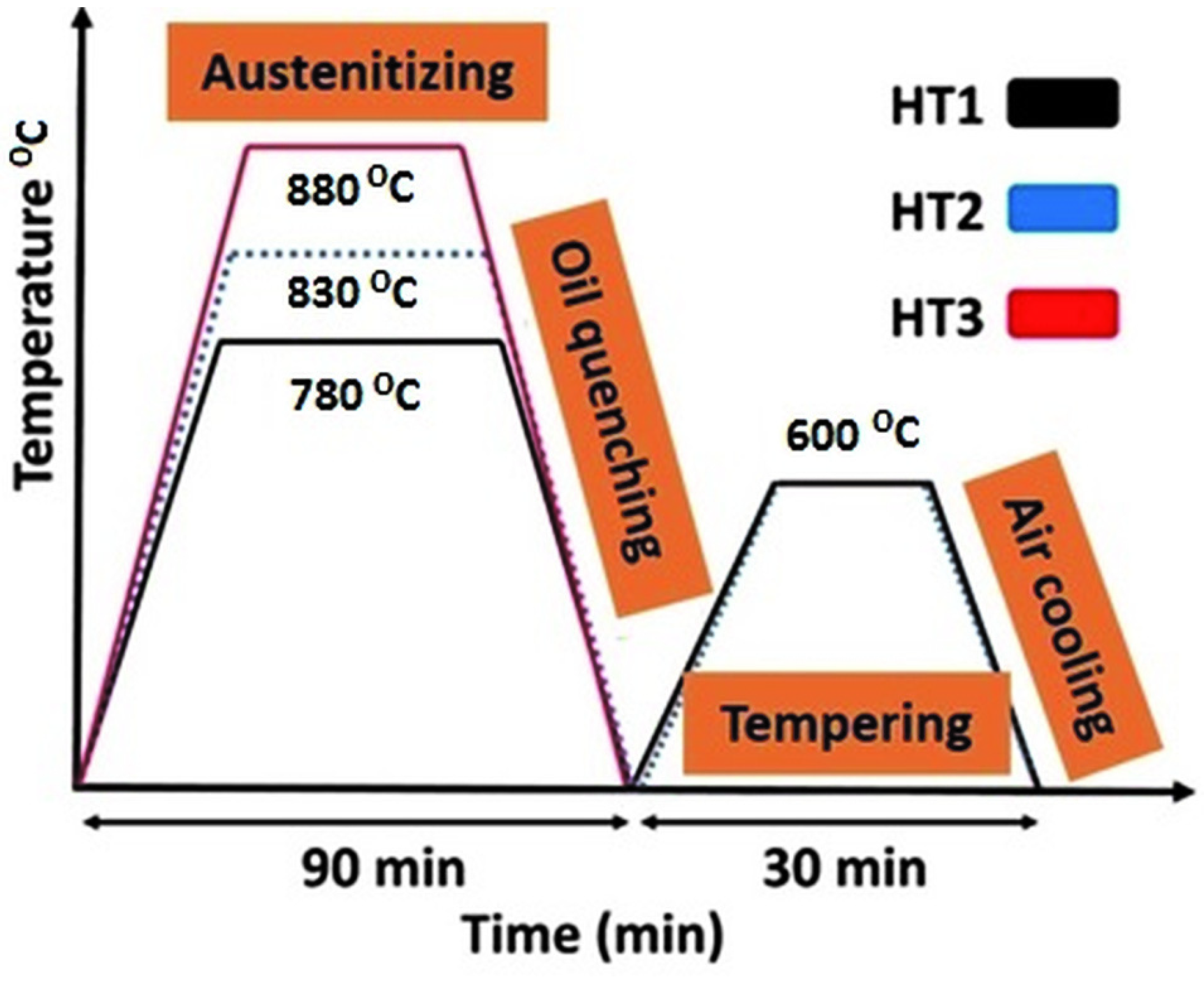
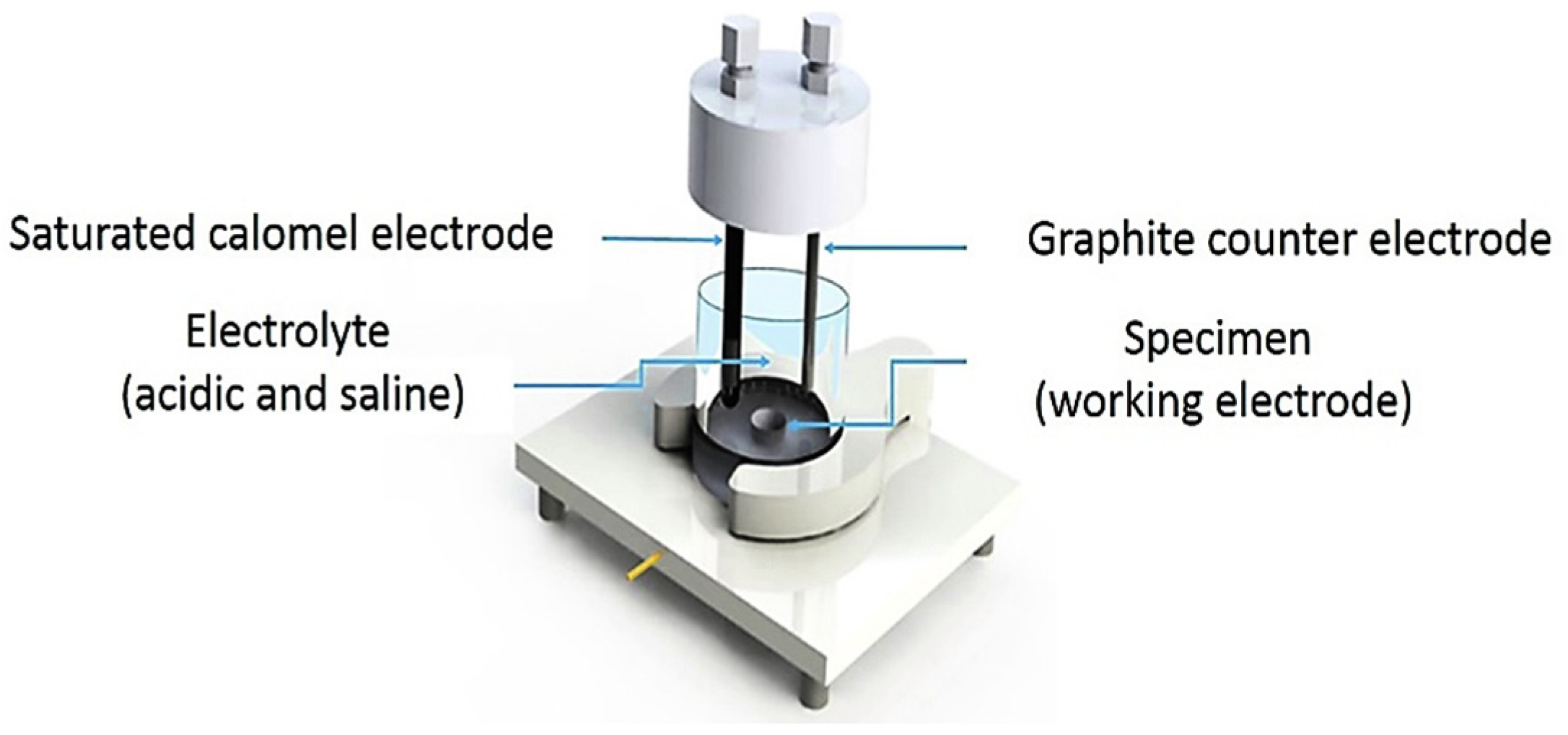
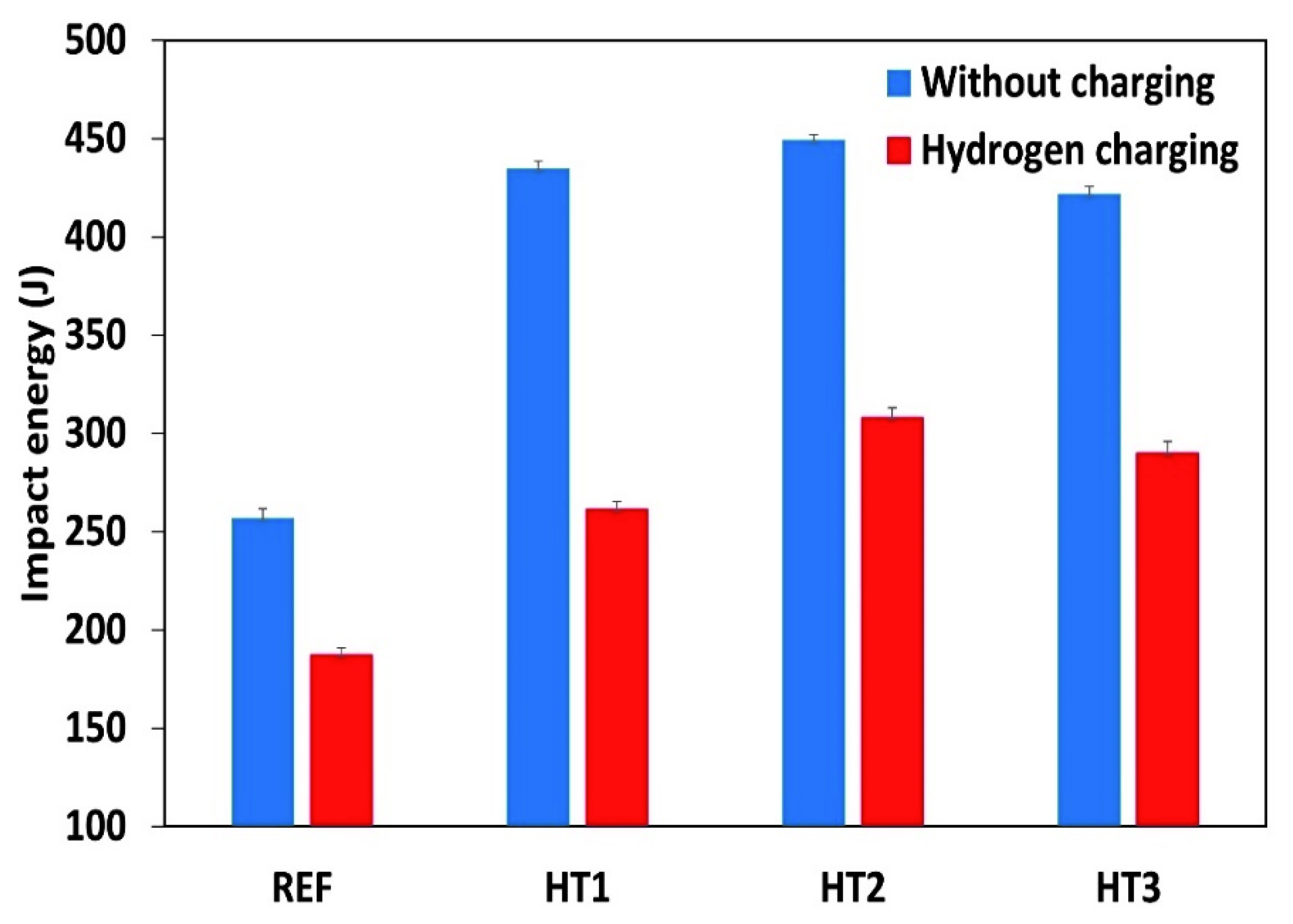
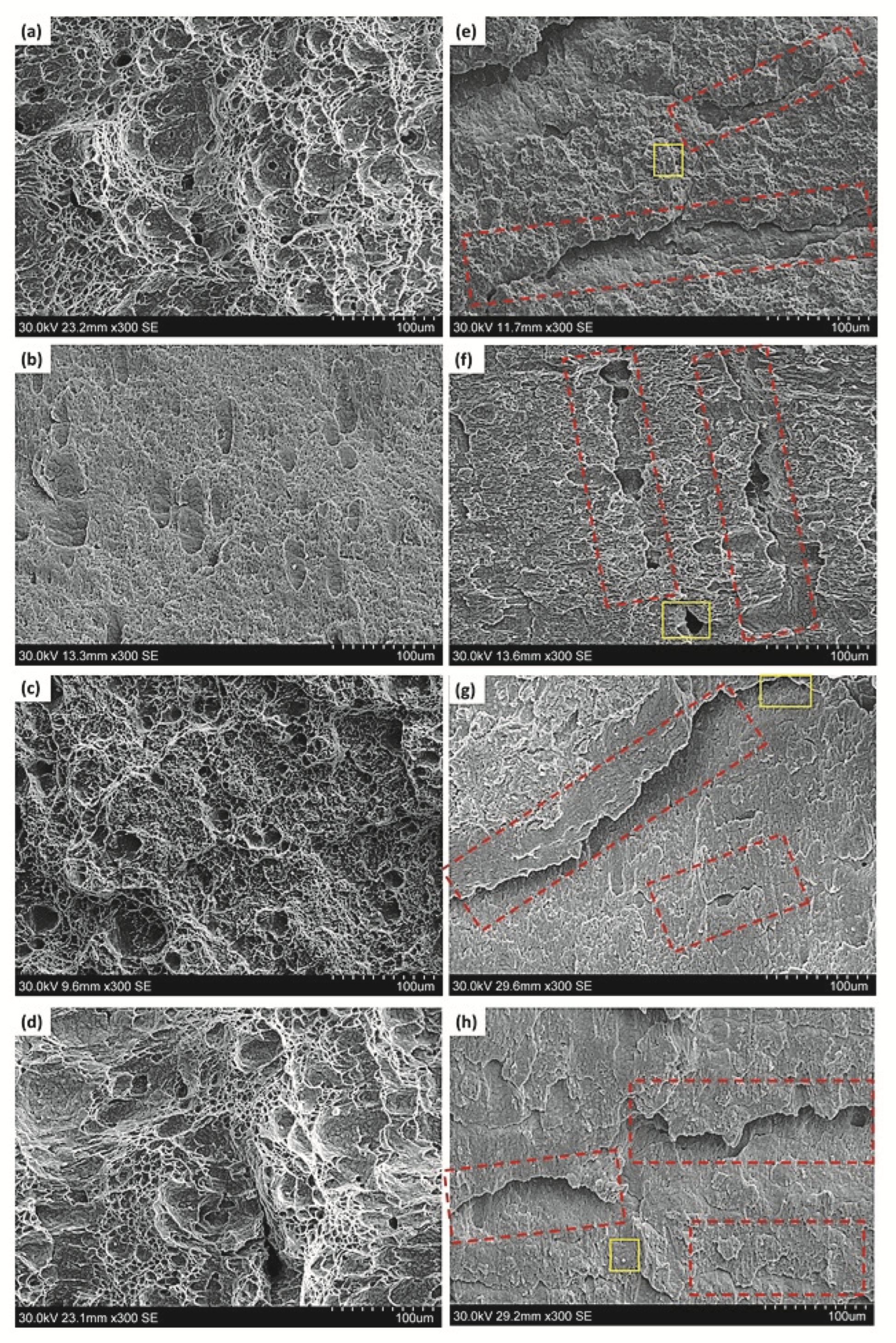
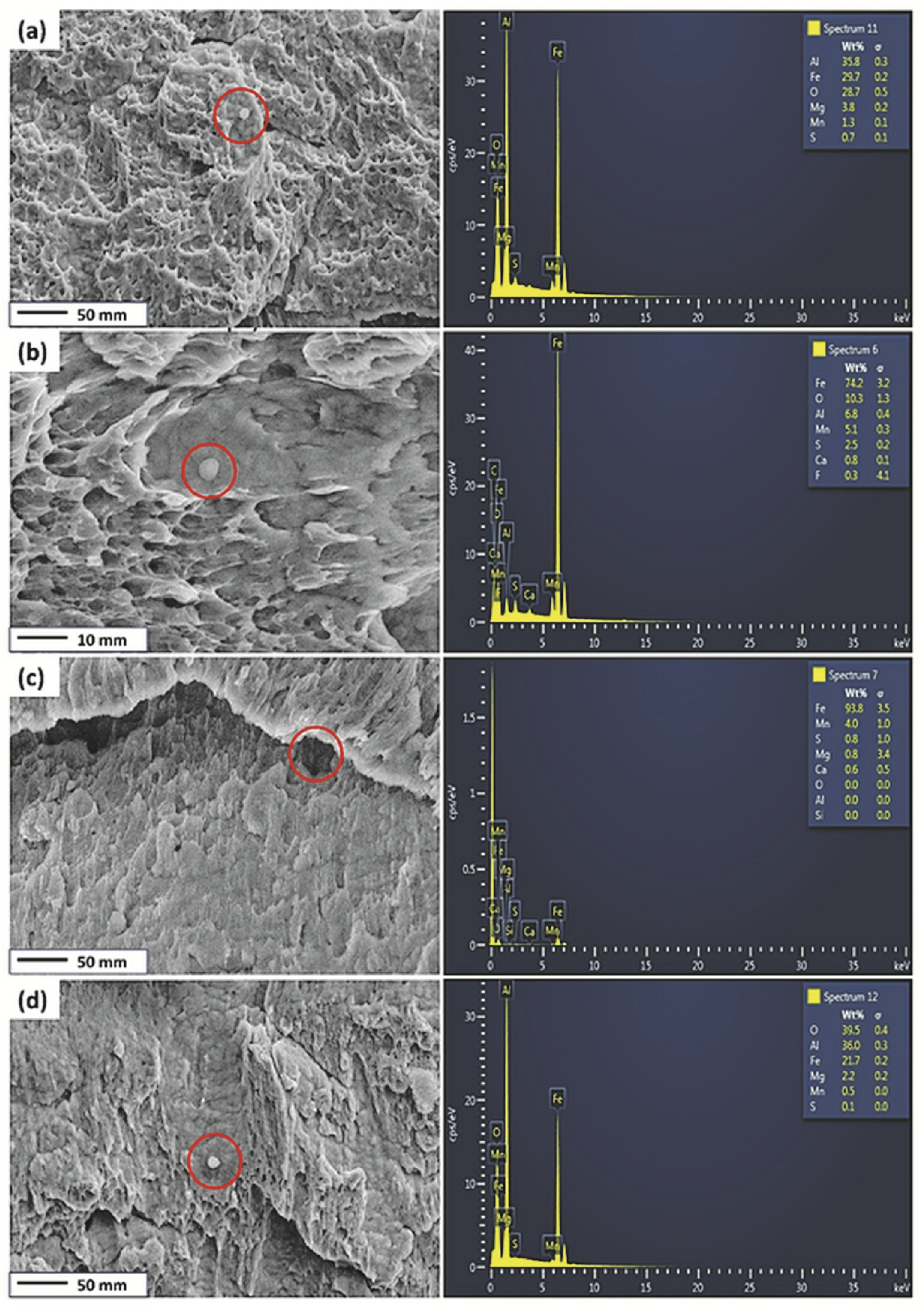
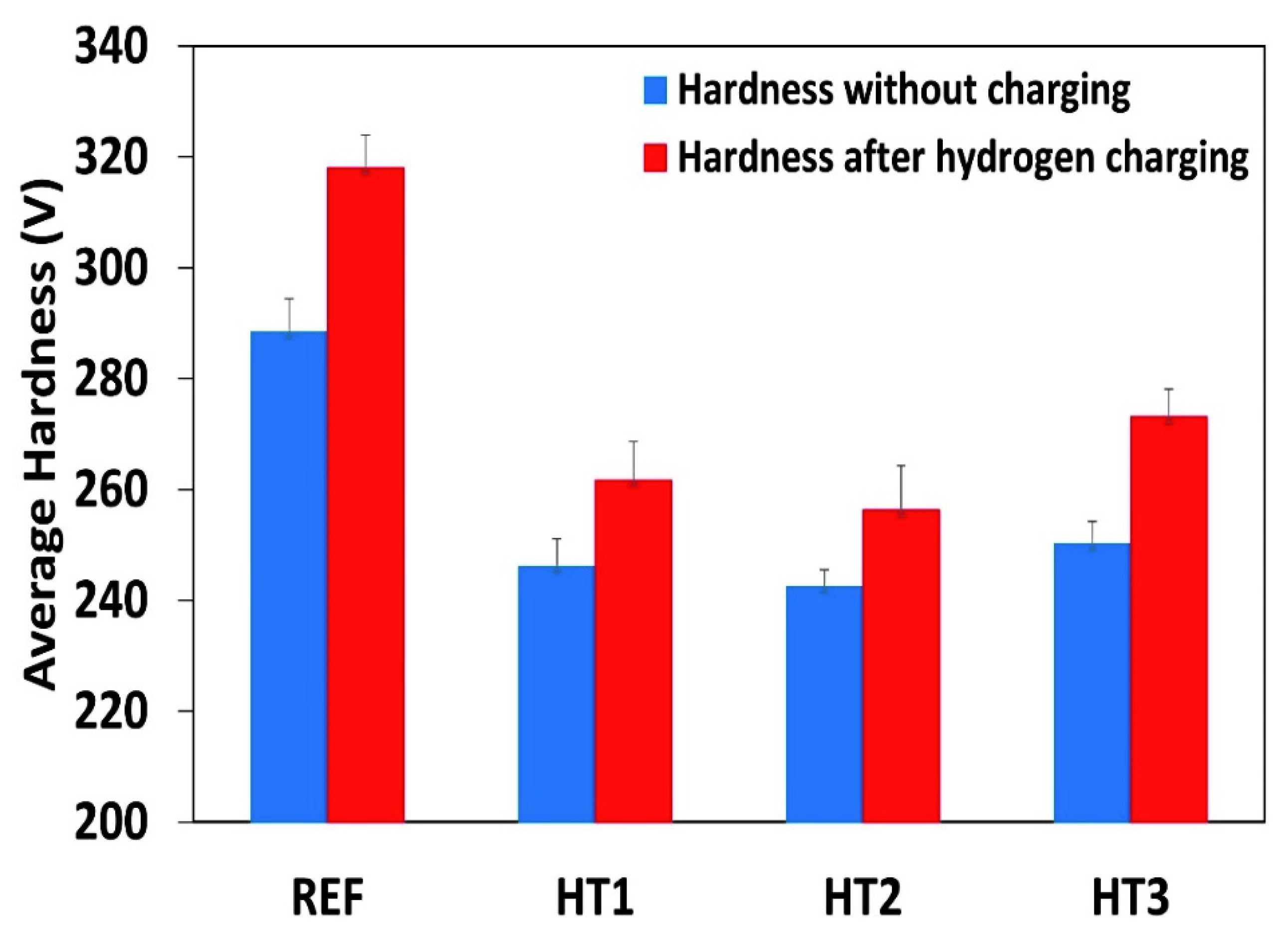
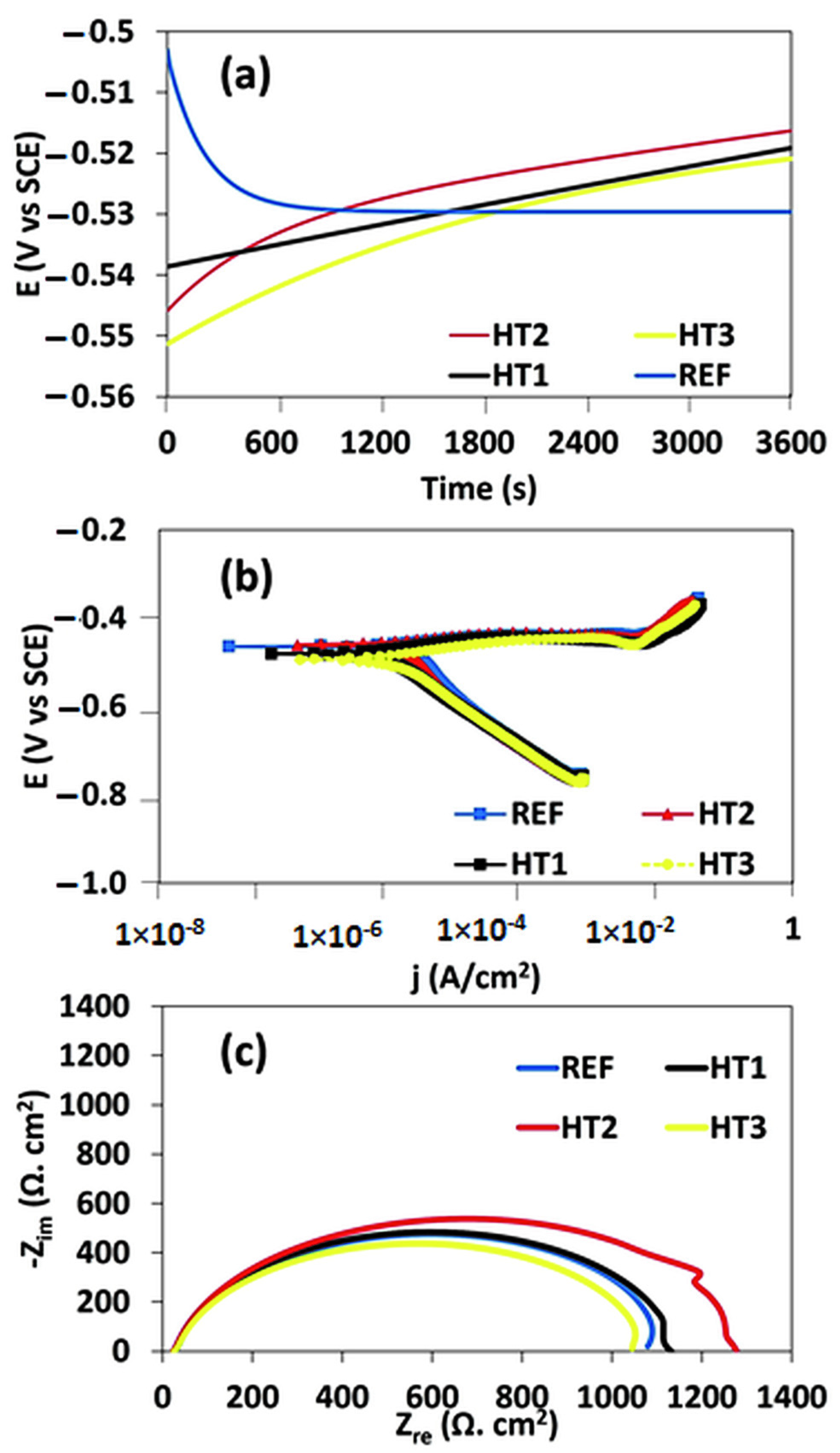

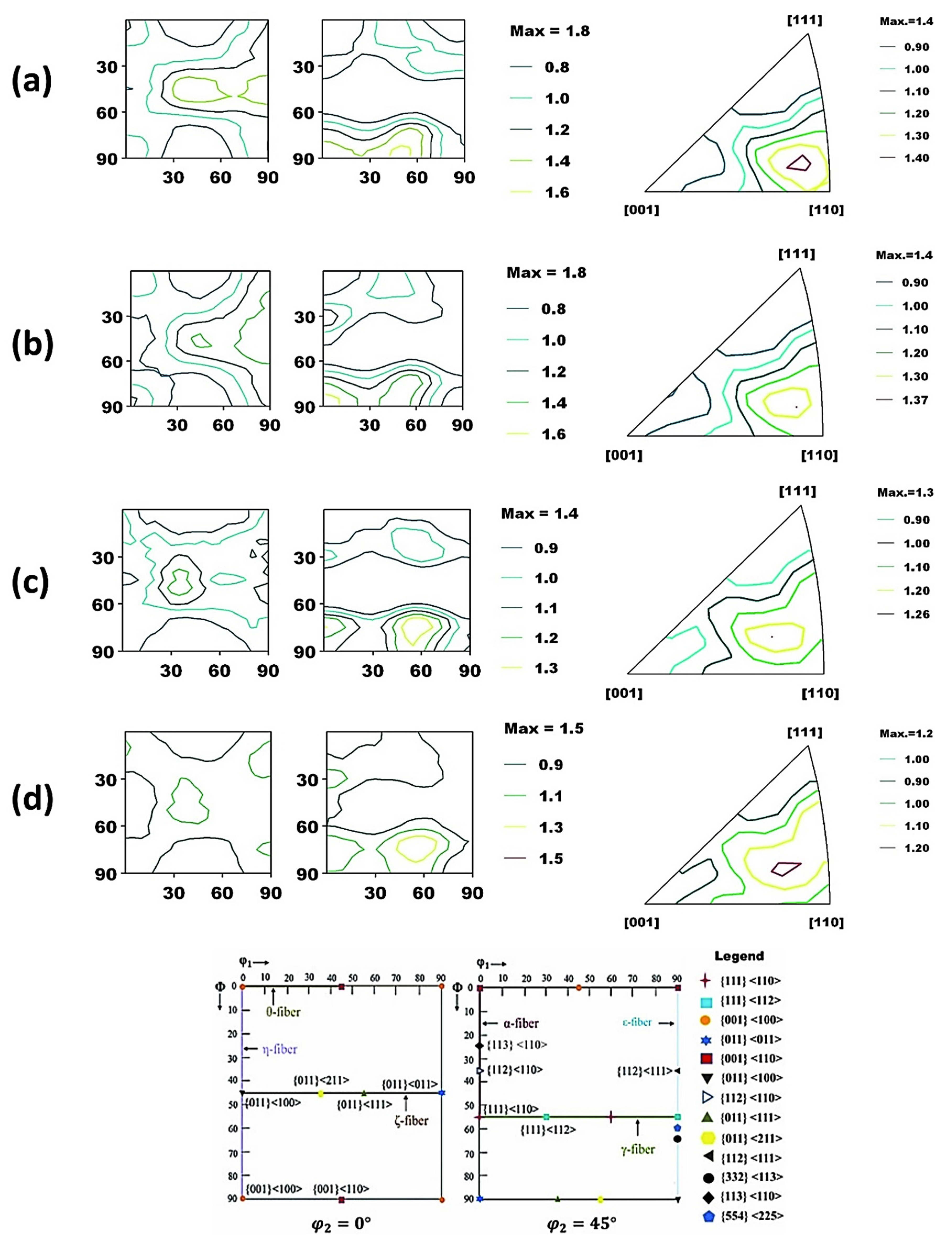
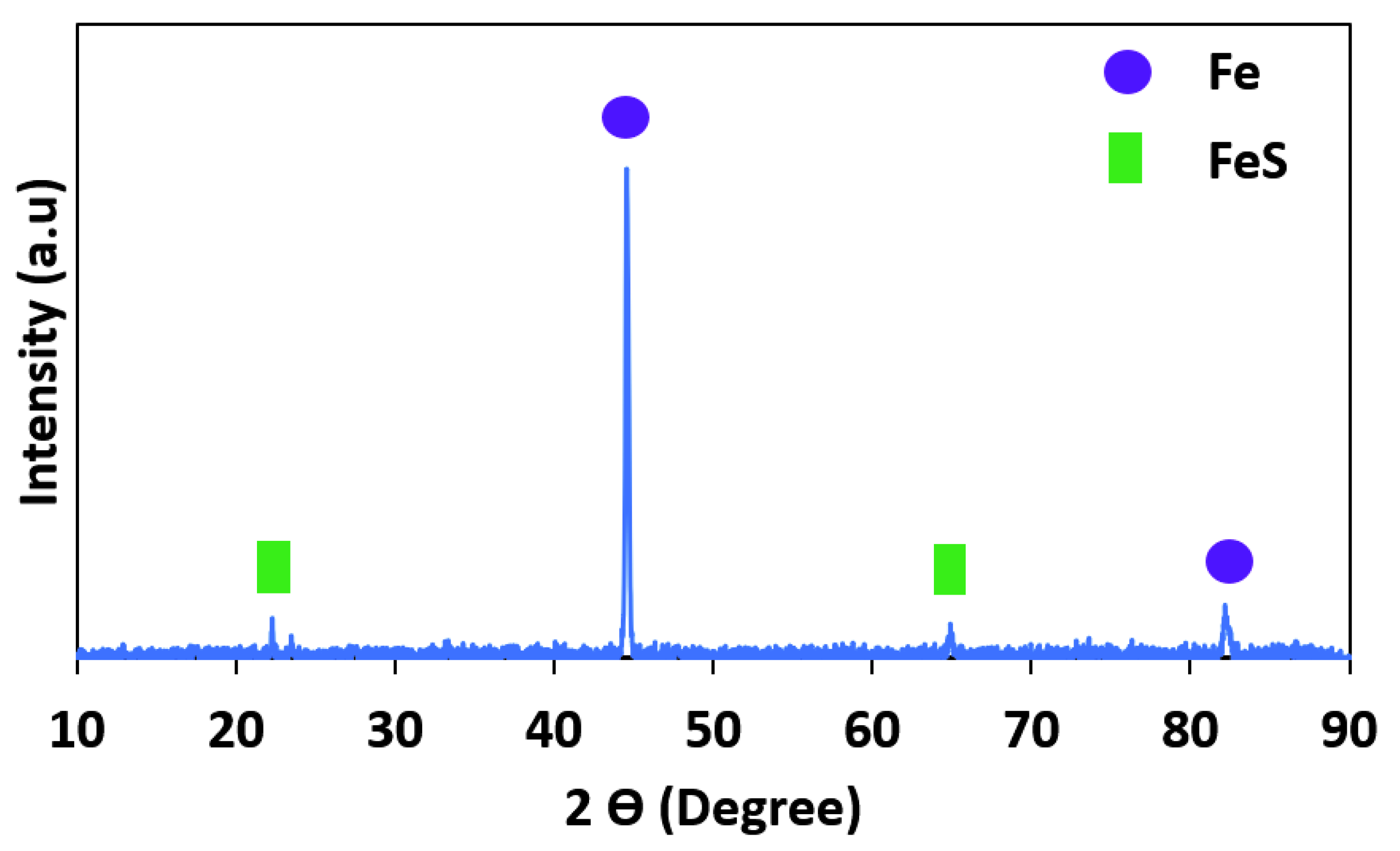
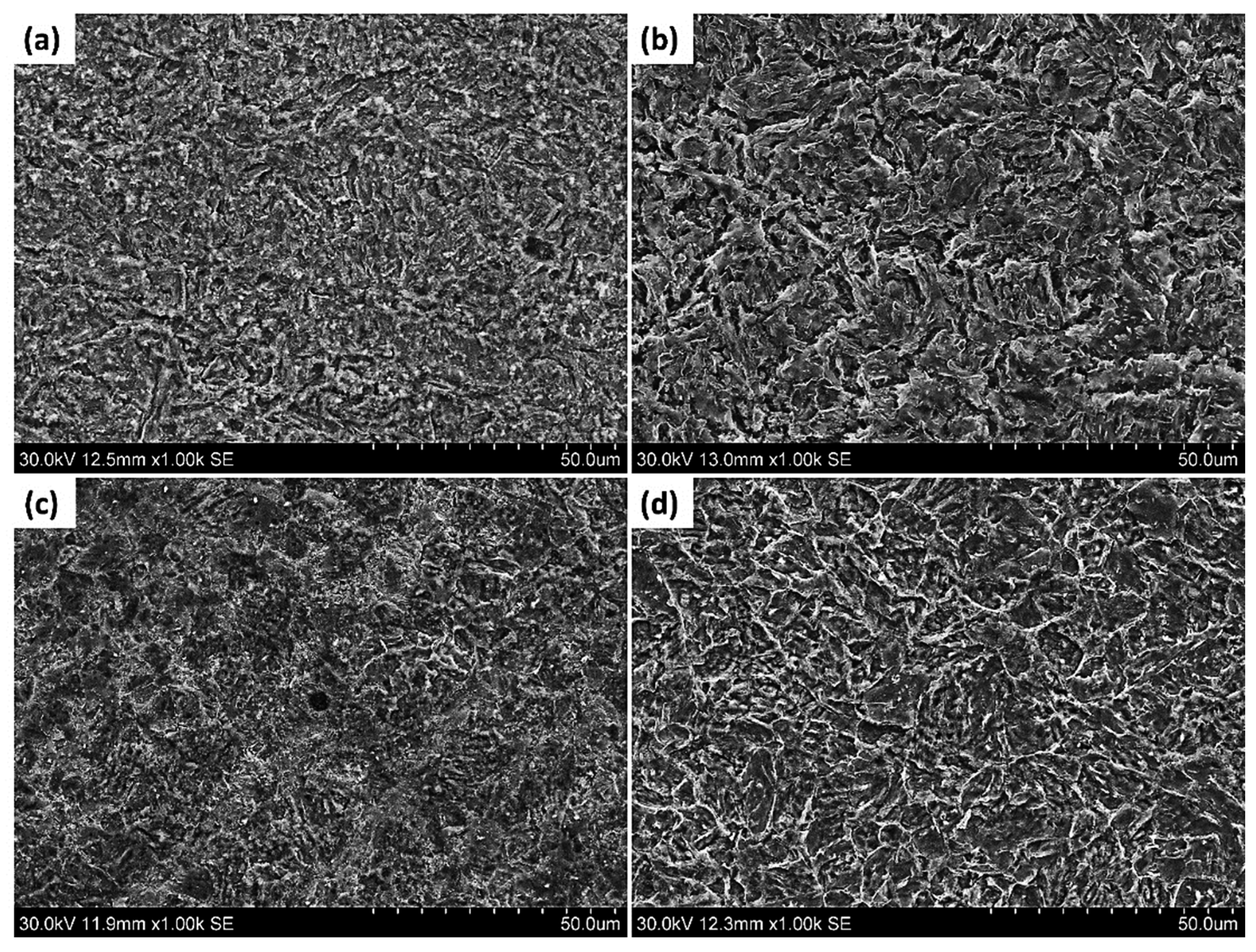
| C | Si | Mn | S | P | Ni | Cr | Mo | V | Cu | Al |
|---|---|---|---|---|---|---|---|---|---|---|
| 0.06 | 0.25 | 1.7 | 0.001 | 0.015 | 0.143 | 0.016 | 0.19 | 0.004 | 0.24 | 0.02 |
| Specimen | Beta A (V/Decade) | Beta C (V/Decade) | Icorr (µA) | Ecorr (mV) | Corossion Rate (mpy) |
|---|---|---|---|---|---|
| Ref. | 27.7 × 10−3 | 170.5 × 10−3 | 12.3 | −464 | 10.6 |
| HT1 | 31.7 × 10−3 | 113.7 × 10−3 | 6.3 | −481 | 3.9 |
| HT2 | 24.8 × 10−3 | 163.2 × 10−3 | 5.9 | −460 | 2.5 |
| HT3 | 31.2 × 10−3 | 109.3 × 10−3 | 14.8 | −493 | 15.6 |
| Texture Components | Ref. | HT1 | HT2 | HT3 |
|---|---|---|---|---|
| Cube | 2.5 | 2.5 | 2.1 | 2.3 |
| Goss | 2 | 1.8 | 2.2 | 1.8 |
| Brass | 6.4 | 5.8 | 5.4 | 5.4 |
| S | 10.8 | 9.1 | 10.1 | 9.7 |
| Copper | 4.4 | 3.4 | 4.1 | 3.7 |
| R-cube | 1.5 | 1.6 | 1.7 | 1.6 |
| ϒ {111}ǀǀND | 9.2 | 9.7 | 10.8 | 11.6 |
| Ratio gamma to R-cube | 6.1 | 6.2 | 6.2 | 6.9 |
| α {110}ǀǀRD | 9.6 | 8.8 | 9.3 | 8.5 |
| {332} <113> | 26.3 | 27.1 | 28.2 | 29.2 |
Disclaimer/Publisher’s Note: The statements, opinions and data contained in all publications are solely those of the individual author(s) and contributor(s) and not of MDPI and/or the editor(s). MDPI and/or the editor(s) disclaim responsibility for any injury to people or property resulting from any ideas, methods, instructions or products referred to in the content. |
© 2023 by the authors. Licensee MDPI, Basel, Switzerland. This article is an open access article distributed under the terms and conditions of the Creative Commons Attribution (CC BY) license (https://creativecommons.org/licenses/by/4.0/).
Share and Cite
Khatib Zadeh Davani, R.; Mohtadi-Bonab, M.A.; Yadav, S.; Entezari, E.; Cabezas, J.F.A.; Szpunar, J. Effect of Quench Tempering on Hydrogen Embrittlement and Corrosion Behavior of X100 Pipeline Steel. Metals 2023, 13, 841. https://doi.org/10.3390/met13050841
Khatib Zadeh Davani R, Mohtadi-Bonab MA, Yadav S, Entezari E, Cabezas JFA, Szpunar J. Effect of Quench Tempering on Hydrogen Embrittlement and Corrosion Behavior of X100 Pipeline Steel. Metals. 2023; 13(5):841. https://doi.org/10.3390/met13050841
Chicago/Turabian StyleKhatib Zadeh Davani, Reza, Mohammad Ali Mohtadi-Bonab, Sandeep Yadav, Ehsan Entezari, Jhon Freddy Aceros Cabezas, and Jerzy Szpunar. 2023. "Effect of Quench Tempering on Hydrogen Embrittlement and Corrosion Behavior of X100 Pipeline Steel" Metals 13, no. 5: 841. https://doi.org/10.3390/met13050841
APA StyleKhatib Zadeh Davani, R., Mohtadi-Bonab, M. A., Yadav, S., Entezari, E., Cabezas, J. F. A., & Szpunar, J. (2023). Effect of Quench Tempering on Hydrogen Embrittlement and Corrosion Behavior of X100 Pipeline Steel. Metals, 13(5), 841. https://doi.org/10.3390/met13050841









